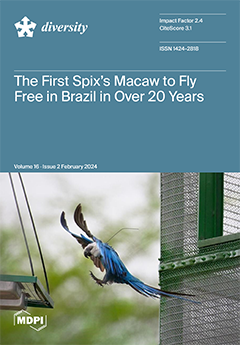In the Mediterranean Sea, the bivalve genus
Pinna is represented by two species: the endemic
Pinna nobilis and the (sub)tropical Atlantic
Pinna rudis.
P. rudis is generally less common and mostly restricted to the warmer regions of the western Mediterranean. However, since
[...] Read more.
In the Mediterranean Sea, the bivalve genus
Pinna is represented by two species: the endemic
Pinna nobilis and the (sub)tropical Atlantic
Pinna rudis.
P. rudis is generally less common and mostly restricted to the warmer regions of the western Mediterranean. However, since a mass mortality event, caused by a pathogen infection, has brought
P. nobilis to the brink of extinction, records of
P. rudis have increased in several Mediterranean regions, where it had not been previously observed. This paper reports on the presence of several
P. rudis individuals in the Ligurian Sea, the northernmost reach of this species in the western Mediterranean.
P. rudis has become increasingly common between 2021 and 2023, with a total of 28 new records from seven localities along the Ligurian coast. The size of the individuals and their estimated growth rate (3.6 cm·a
−1) indicated that a recruitment event most likely took place in summer 2020, when
P. nobilis was no longer present in the area. Our observations suggest that the recruitment success of
P. rudis increased following the decline of
P. nobilis. However, considering the thermophilic nature of
P. rudis, in all likelihood, the ongoing water warming is playing a crucial role in the successful establishment of this species in the Ligurian Sea. A full understanding of the recent range expansion of
P. rudis in the Mediterranean is far from being achieved, and whether
P. rudis will be able to fulfil the ecological role of
P. nobilis is difficult to predict. Large scale monitoring remains the only effective way to know about the future of Pinnids in the Mediterranean Sea.
Full article





